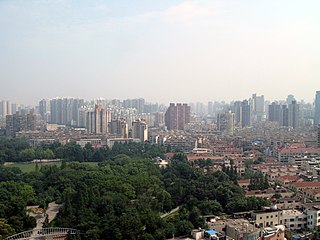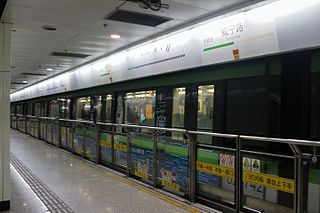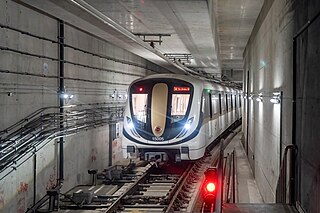
A trolleybus is an electric bus that draws power from dual overhead wires using spring-loaded trolley poles. Two wires, and two trolley poles, are required to complete the electrical circuit. This differs from a tram or streetcar, which normally uses the track as the return path, needing only one wire and one pole. They are also distinct from other kinds of electric buses, which usually rely on batteries. Power is most commonly supplied as 600-volt direct current, but there are exceptions.

Changning is a district of Shanghai, China. It has a land area of 37.19 square kilometres (14.36 sq mi) and had a population of 620,000 as of 2003. The district government is located at 1320 Yuyuan Rd.

A dual-mode bus is a bus that can run independently on power from two different sources, typically electricity from overhead lines like a trolleybus or from batteries like a hybrid bus, alternated with conventional fossil fuel. In contrast to other hybrid buses, dual-mode buses can run forever exclusively on their electric power source (wires). Several of the examples listed below involve the use of dual-mode buses to travel through a tunnel on electric overhead power.

Line 2 is an east–west line in the Shanghai Metro network. With a length of nearly 64 km (40 mi), it is the second longest line in the metro system after line 11. Line 2 runs from East Xujing in the west to Pudong International Airport in the east, passing Hongqiao Airport, the Huangpu river, and the Lujiazui Financial District in Pudong. With a daily ridership of over 1.9 million, it is the busiest line on the Shanghai Metro. The eastern portion of the line, from Guanglan Road to Pudong International Airport, was operated almost independently from the main segment until April 19, 2019, when through service began. The line is colored light green on system maps.

Line 3 is a north–south line of the Shanghai Metro network. Its older rolling stock carry a bright yellow colour belt to differentiate them from Line 4 trains which share a portion of its route, while the newer stock features a yellow and purple livery, which the exact line is labelled using sticker or screens saying “Line 3” or “Line 4”. Unlike the majority of the lines in the Shanghai Metro system, Line 3 is primarily elevated, entirely above ground except for Tieli Road, located at the entrance to Baosteel Group Corporation. The line runs from North Jiangyang Road in the north to Shanghai South Railway Station in the southwest of the city, where it meets line 1. While line 1 goes straight through the city center, line 3 roughly follows the Inner Ring Road around the city from Caoxi Road to Zhongtan Road. The line has about 300 drivers. Between December 26, 2000, and August 8, 2002, the line operated under the name Pearl Line; On August 8, 2002, it was renamed as Rail Transit Line 3. The line is colored yellow on system maps.

Hongqiao Road is an interchange station between Lines 3, 4 and 10 on the Shanghai Metro. It is the southernmost station of which Lines 3 and 4 share the same tracks. The station opened on 26 December 2000 as part of the initial section of Line 3 from Shanghai South Railway Station to Jiangwan Town, and Line 4 service began here on the final day of 2005. The interchange with Line 10 opened on 10 April 2010.

Shanghai has around 2000 formal bus lines, served by more than 10 bus companies. In the past, Bashi, Dazhong, Guanzhong and Qiangsheng were the four largest; around 2009 they merged to become Bashi Group Companies, including Bashi No.1-6 Bus Passenger Service Companies, Bashi Tram, Bashi Xinxin and Chongming Company, Baoshan Company and Jinshan Company. Each Suburban district also renewed with one company serving each district. Around 2015, Bashi No.1 Passenger Service and Bashi Tram merged to be Bashi No.1 Company, Bashi No.2 Passenger Service became Bashi No.2 Company, Bashi No.3, No.4 Passenger Service merged to be Bashi No.3 Company, Bashi No.6 Passenger Service became Bashi No.4 Company, and Bashi No.5 Passenger Service and Baoshan Company became Bashi No.5 Company.

Translohr is a rubber-tyred tramway system, originally developed by Lohr Industrie of France and now run by a consortium of Alstom Transport and Fonds stratégique d'investissement (FSI) as newTL, which took over from Lohr in 2012. It is used in Paris and Clermont-Ferrand, France; Medellín, Colombia; and Venice-Mestre and Padua in Italy. In June 2012, Alstom Group and the Strategic Investment Fund acquired Translohr for €35 million.

Songhong Road is a station on Line 2 of the Shanghai Metro in Changning District. The station served as the western terminus of the line from 30 December 2006, when Line 2 was extended westward from Zhongshan Park, until 16 March 2010, when the second westward extension to the current terminus at East Xujing opened. The station is still often used as a terminus for west-bound trains meaning passengers have to disembark and wait for another train for the remainder of the journey.

Weining Road is a station on Line 2 of the Shanghai Metro in Changning District. It is part of the western extension of that line from Zhongshan Park to Songhong Road that opened on 30 December 2006.

Line 15 of the Shanghai Metro is a north-south metro line in the city of Shanghai that opened on 23 January 2021. The line begins at Gucun Park in Baoshan District at its northern end, and terminates at Zizhu Hi-tech Park in Minhang District at its southern end, via Shanghai West Railway Station and Shanghai South Railway Station. It will be 42.3 kilometres (26.3 mi) in length and have 30 stations. The line is one of Shanghai Metro's new batch of high capacity fully automated and driverless lines along with Lines 14 and 18. The line is colored ivory on system maps.

The Vancouver trolley bus system forms part of the TransLink public transport network serving Metro Vancouver in the Canadian province of British Columbia. Opened in 1948, the system was originally owned and operated by the British Columbia Electric Railway. By 1954, Vancouver had the largest trolley bus fleet in Canada, with 327 units, and the fleet grew to an all-time peak of 352 in early 1957. There were 19 routes by 1955 and a peak of 20 by the second quarter of 1957. The last route to open in the 1950s was the only express trolley bus service that ever existed in Canada. Several, mostly short, extensions to the system were constructed in the 1980s and later.

The Modena trolleybus system forms part of the public transport network of the city and comune of Modena, in the region of Emilia-Romagna, northern Italy.

The Shanghai trolleybus system is a system of trolleybuses forming part of the public transport network in the city of Shanghai, China. Of more than 300 trolleybus systems in operation worldwide, the Shanghai system is the oldest. The system turned 100 years old in November 2014 and was the first trolleybus system anywhere in the world to reach that milestone.

Public bus service in Beijing is among the most extensive, widely used and affordable form of public transportation in urban and suburban districts of the city. In 2015, the entire network consisted of 876 routes with a fleet of 24,347 buses and trolleybuses carried 3.98 billion passengers annually. Trolleybuses run on over 31 routes including 6, 38, 42, 65, 101-112, 114-118, 124, 128, 301, BRT 1-3. Many of these trolleybus routes are located inside the Third Ring Road but some, such as 301 and BRT 1-3, do extend as far out as the Fifth Ring Road. Since 2013, In an effort to reduce urban air pollution, Beijing has been converting regular bus routes to trolleybus routes by installing overhead power lines on several corridors. Public bus service in the city began in 1921. Today there are two operators. The city's primary public bus operator, the state-owned Beijing Public Transport Holdings, Ltd. operates the Bus Service.

Zhengzhou Bus Rapid Transit is a bus rapid transit system in Zhengzhou, the capital of Henan Province in the People's Republic of China. The system has 5 main trunk routes with dedicated bus lanes along with a number of feeder routes that run for a portion of the corridor and serves other areas.

Zhengzhou BRT Route B2 is a bus rapid transit route operated by Zhengzhou Bus. It is the 2nd route with dedicated bus lanes in Zhengzhou BRT.

The Yan'an Road Medium Capacity Bus Transit System is a bus rapid transit system operating within Shanghai, China. The network consists of a main route, a partial route and four branch lines, with the main route running between East Yan'an Road & The Bund in Huangpu District and Shenkun Road Bus Terminal in Minhang District via Yan'an Road. The system is operated by Shanghai Bus No.3 Public Transport Co., Ltd., and began trial operations on 1 February 2017.

The BYD B series are a line of battery electric buses produced by Chinese vehicle manufacturer BYD. It is the first bus model powered by BYD's Lithium Iron Phosphate Blade batteries. It is available as a 10-metre single-decker (B10), a 11-metre double-decker bus (BD11), a 12-metre single-decker (B12), a 12-metre double-decker (B12D), a 15-metre tri-axled single-decker (B15) and a 18-metre articulated bus (B18).

Trolleybus Route 20 is a trolleybus route in Shanghai, China. It started operations on 27 September 1928, and runs between Zhongshan Park in Changning District and Hankou Road & Middle Sichuan Road in Huangpu District. It is operated by Shanghai Bus No.1 Public Transportation Co. Ltd.



















